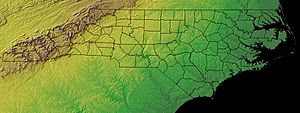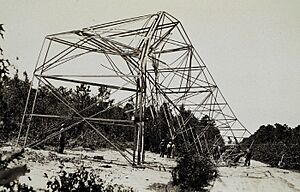List of North Carolina hurricanes (1900–1949) facts for kids

Hurricanes are powerful storms that form over warm ocean waters. They bring strong winds, heavy rain, and can cause big waves and flooding. This article is about the many tropical storms and hurricanes that affected the U.S. state of North Carolina between 1900 and 1949.
During this time, 75 tropical storms or their leftover parts hit North Carolina. These storms caused 53 deaths and about $328 million in damage (that's how much it would be worth today). Almost every year, North Carolina was hit by at least one storm, except for nine years. The year 1916 was the busiest, with five storms affecting the state.
The strongest hurricanes to hit North Carolina during this period were the 1933 Outer Banks hurricane and the 1944 Great Atlantic Hurricane. Both were as strong as a Category 3 hurricane on the Saffir–Simpson hurricane scale, which is a way we measure hurricane strength. The 1933 Outer Banks hurricane was the deadliest, killing 21 people. In 1940, the leftover parts of a hurricane caused huge floods and landslides, leading to over $150 million in damage. Most storms hit North Carolina in September, but they could happen any time between May and December.
Contents
Storms in the Early 1900s (1900-1909)
Many storms brushed past or moved through North Carolina in the early 1900s. Most of them caused only minor damage or strong winds.
- October 13, 1900: A tropical storm's leftover parts moved along the coast.
- July 11, 1901: A hurricane hit the Outer Banks, bringing strong winds but not much damage.
- September 14, 1904: A hurricane crossed the state after hitting South Carolina. It caused a lot of damage and one person died.
- July 31, 1908: A hurricane moving across the state brought very heavy rain. This caused bad flooding near the coast. There was a lot of local damage, but no one was reported hurt.
Storms in the 1910s (1910-1919)
This decade saw some powerful storms, including a very active year in 1916.
- September 3, 1913: A hurricane hit North Carolina, causing a lot of damage to farms and buildings. Strong winds and high tides washed away several bridges. Five people died, and the damage was about $65 million in today's money.
- May 16, 1916: A tropical storm weakened as it crossed the eastern part of the state.
- July 15, 1916: The leftover parts of a tropical storm dropped a record-breaking 22.22 inches (564 mm) of rain in 24 hours in Highlands, North Carolina. This was the most rain recorded in one day in the entire United States at that time! The rain caused landslides and floods, killing 11 people.
- August 24, 1918: A weak hurricane crossed the eastern part of the state, causing some local damage.
Storms in the 1920s (1920-1929)
The 1920s brought more storms, some of which caused serious flooding and damage.
- September 22, 1920: A strong tropical storm hit near Wilmington. It damaged or destroyed several buildings, and one person died.
- August 25, 1924: A hurricane passed just east of Hatteras. Its storm surge (a rise in sea level) flooded parts of Ocracoke Island, and two people drowned.
- August 17, 1928: Another tropical storm brought more rain to western North Carolina. This caused severe flooding that destroyed several homes. The damage was over $12.6 million in today's money. Six people died in the state, with four of those deaths due to flooding.
- September 18, 1928: The famous 1928 Okeechobee Hurricane (after it weakened) caused heavy rain and severe river flooding in southeastern North Carolina. This flooding closed roads and washed out bridges.
- October 29, 1929: A former hurricane from Florida brought heavy rain, causing severe flooding. The Cape Fear River rose an amazing 41 feet (12.5 meters) in just 24 hours! This storm damaged roads, farms, and businesses.
Storms in the 1930s (1930-1939)
This decade included one of the deadliest hurricanes for North Carolina.
- August 23, 1933: The 1933 Chesapeake Potomac Hurricane hit the northeastern part of the state. It caused a lot of local damage and high tides. The damage was estimated at $4 million in today's money.
- September 15, 1933: The 1933 Outer Banks hurricane brought very heavy rain, strong winds, and high tides. Several homes were destroyed, leaving about 1,000 people without a place to live. The damage reached $74.6 million in today's money. A total of 21 people died in North Carolina from this storm, making it the deadliest hurricane in the state during this period.
- September 18, 1936: A hurricane hit Hatteras and was described as one of the worst ever seen there. Strong winds destroyed crops near the coast, and high tides caused beaches to wash away. Luckily, no deaths were reported.
- September 21, 1938: The New England Hurricane of 1938 passed just east of the Outer Banks, bringing heavy rain and strong winds.
- August 18, 1939: A tornado, caused by a weakening tropical storm, killed one person in the state.
Storms in the 1940s (1940-1949)
The 1940s also saw significant storms, including another one that caused widespread flooding.
- August 15, 1940: The leftover parts of a former hurricane faded away in the state. But before they did, they dropped a massive 19.6 inches (498 mm) of rain in Swansboro. This caused severe river flooding, flash floods, and mudslides. Thousands of people lost their homes. Over 20 people died, many because of mudslides. The damage was more than $154 million in today's money.
- August 1, 1944: A hurricane hit south of Wilmington, causing a lot of damage in a small area. Most of the $2 million in damage (from 1944) was to crops. No one was reported hurt.
- September 14, 1944: The 1944 Great Atlantic Hurricane passed just east of the Outer Banks. It set records at the time for the strongest winds and lowest pressure in Hatteras. The storm destroyed 108 buildings and damaged 667 more along the coast. This caused $17.8 million in damage (in today's money). One person died in the state.
- October 20, 1944: A former hurricane crossed the eastern part of the state, causing power outages and coastal flooding.
- September 17, 1945: Very heavy rain from a tropical storm crossing the state caused major river flooding across eastern North Carolina. Some dams broke, and there were reports of a lot of local damage.
- August 24, 1949: A storm brushed the Outer Banks with moderate rain and hurricane-force winds, leading to two deaths.
- August 28, 1949: A tropical storm crossed the western part of the state, bringing several tornadoes and heavy rain. This caused severe river flooding.
When Do Storms Hit North Carolina?
| Month | Number of storms |
|---|---|
| May |
3
|
| June |
4
|
| July |
8
|
| August |
18
|
| September |
25
|
| October |
15
|
| November |
1
|
| December |
1
|
As you can see from the graph, most storms hit North Carolina in September. August and October are also busy months for storms. It's rare for storms to hit in May, June, November, or December, and no storms were recorded in April during this period.
Deadliest Storms in North Carolina
This table shows the storms that caused the most deaths in North Carolina between 1900 and 1949.
| Name of Storm | Year | Number of Deaths |
|---|---|---|
| Outer Banks Hurricane | 1933 | 21 |
| Unnamed | 1916 | 11 |
| Unnamed | 1928 | 6 |
| Unnamed | 1913 | 5 |
| Unnamed | 1924 | 2 |
| Georgia-South Carolina Hurricane | 1940 | 2 |
| Unnamed | 1949 | 2 |
| Unnamed | 1904 | 1 |
| Unnamed | 1920 | 1 |
| Unnamed | 1939 | 1 |
| Great Atlantic Hurricane | 1944 | 1 |
See also
- List of North Carolina hurricanes
- Geography of North Carolina



